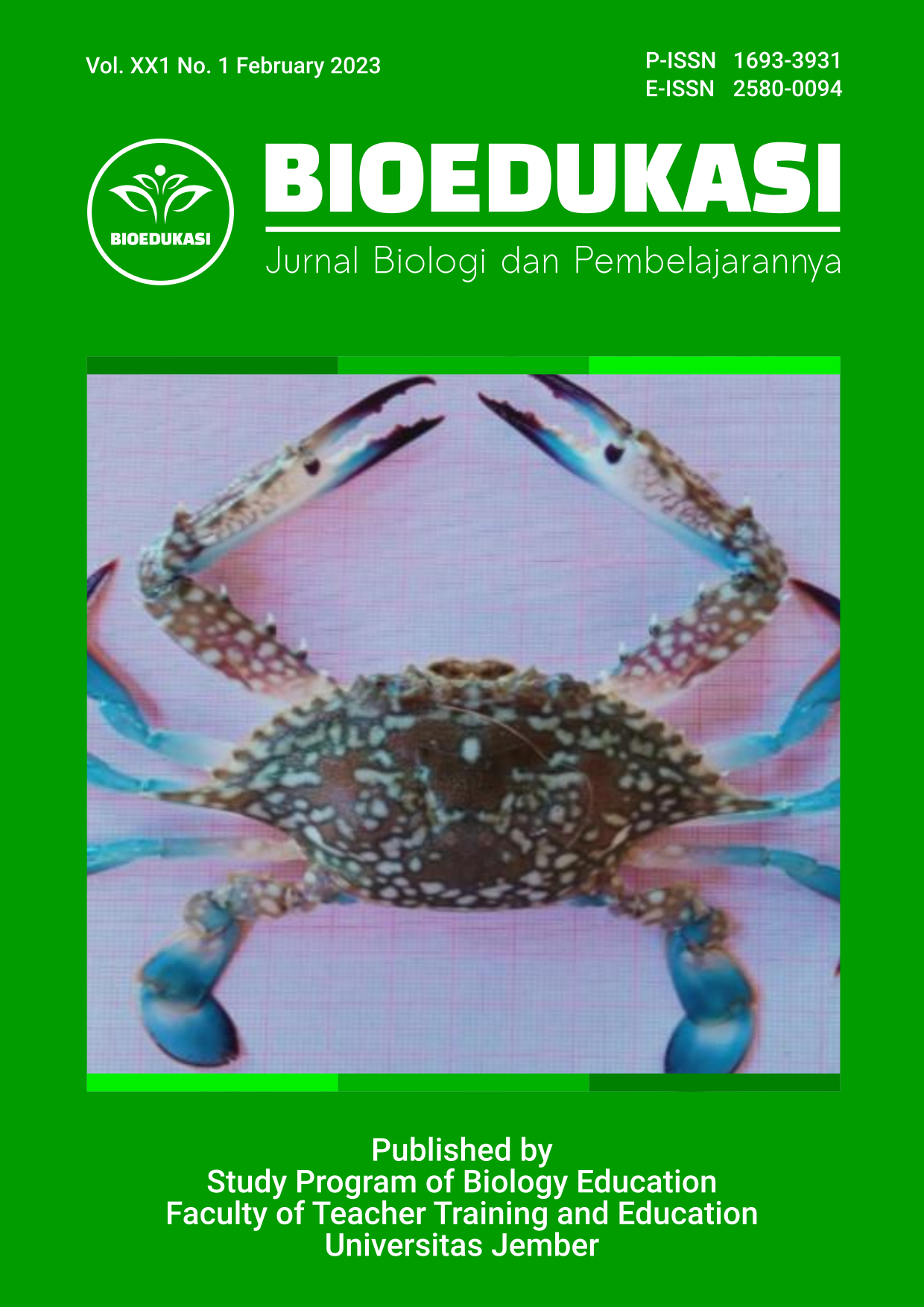BANYUWANGI CUSTOM RITUAL ETHNOBOTANY-BASED MODULE DEVELOPMENT ON BIODIVERSITY MATERIALS TO TRAIN PLANT LITERACY AND PROBLEM-SOLVING ABILITY
DOI:
https://doi.org/10.19184/bioedu.v21i1.36980Keywords:
Biodiversity, Traditional Rituals, ModulesAbstract
The development of this teaching material aims to provide other alternatives in learning activities in the material chapter on biodiversity. The result of this teaching material is in the form of a biodiversity module based on the ethnobotany of Banyuwangi's traditional rituals with the aim of training plant literacy and students' problem-solving skills. The conventional rituals used in the module development are seblang Olehsari, seblang Bakungan, and petik laut Muncar. Module development uses the ADDIE method (Analyze, Design, Development, Implementation, and Evaluate) but module development only reaches the development stage. The modules made are tested for the feasibility of teaching materials and readability tests. The feasibility test of teaching materials consists of material coverage, material accuracy, material up-to-date, insight, appearance, and writing. The results of the eligibility validation of teaching materials showed a validity value of 88.70% with a very high category and showed that the module was very suitable for use in learning, while the results of the readability test using the cloze test contained 5 discourses consisting of 43 questions showing a readability level of 73% in the high category so that students easily understand the module developed in the readability aspect.
Downloads
References
BSNP. (2014). Permendikbud Nomor 59 Tahun 2014 tentang Standar Proses Pendidikan Dasar Dan Menengah. Jakarta: Kemendikbud
Buck T Bruchmann I Zumstein P and Drees C. (2019). Just a small bunch of flowers: the botanical knowledge of students and the positive effects of courses in plant identification at German universities. PeerJ 7 p.e6581
Butler, R. 2016. The Top 10 Most Biodiverse Countries. https://news.mongabay.com/ 2016/05/top-10-biodiverse-countries/. Diakses tanggal 11 Januari 2022
Cimer, A. (2012). What makes Biology Learning Difficult and Effective: Students’ views. Educational Research and Riviews. 7(3): 63-71
Dewi, N.R. & Arini, F.Y. 2018. Uji keterbacaan pada pengembangan buku ajar kalkulus berbantuan geogebra untuk meningkatkan kemampuan pemecahan masalah dan representasi matematis. PRISMA, Prosiding Seminar Nasional Matematika, 1:299-303
Faridah, A. 2019. Pengembangan Bahan Ajar Berbasis Kearifan Lokal Suku Baduy Provinsi Banten serta Efektivitasnya Dalam Meningkatkan Literasi Lingkungan dan Keterampilan Komunikasi Sains Siswa. Tesis. Bandung: Universitas Pendidikan Indonesia.
Griffin, E. (2012). In A First Look At Communication Theory (p. eight edition). Amerika: McGrew Hill
Hemingway, E. (2015). Green Hills of Africa: The Hemingway Library Edition. Simon and Schuster
Kalelioglu, Filiz & Gulbahar, Yasemin. (2014). The effect of instructional techniques on critical thinking and critical thinking dispositions in online discussion. Journal educational technology & society, 17(1): 248-258
Lembaga Ilmu Pengetahuan Indonesia. (2014). Kekinian Keanekaragaman Hayati Indonesia. Jakarta: LIPI Press, anggota Ikapi
Nikmah et al. 2017. Pengembangan booklet berdasarkan kajian potensi dan masalah lokal sebagai buplemen bahan ajar SMK Pertanian. Journal of Innovative Science Education JISE. 6(2):162-169
North American Association for Environmental Education (NAAEE). (2011). National Environmental Literacy Assesment, Phase Two : Measuring the Effectiveness of North American Environmental Educational Programs with Respect to the Parameters of Environmental Literacy. Final Report, submitted to: National Oceanic and Atmospheric Administration, U.S Department of Commerce, and North American Association for Environmenta Education.
Nugraheni, M. (2017). Peningkatan Citra Pangan Lokal. Sosialisasi Penganekaragaman Pangan. Yogyakarta
Prastowo, A. (2014). Panduan Kreatif Membuat Bahan Ajar Inovatif. Yogyakarta: Diva Press.
Prastowo, A. (2018). Sumber belajar dan pusat sumber belajar: Teori dan Aplikasinya di Sekolah/Madrasah. Kencana.
Rahmatih, A. N., Yuniastuti, A., & Susanti, R. (2018). Pengembangan booklet berdasarkan kajian potensi dan masalah lokal sebagai suplemen bahan ajar SMK Pertanian. Prosiding Seminar Nasional Pendidikan Biologi dan Saintek Ke-3.
Rahmawati, D., Nugroho, S. E., & Putra, N. M. D. (2014). Penerapan model pembelajaran kooperatif tipe numbered head together berbasis eksperimen untuk meningkatkan keterampilan proses sains siswa SMP. UPEJ Unnes Physics Education Journal, 3(1)
Ridhwan, M. (2012). Tingkat keanekaragaman hayati dan pemanfaatannya di Indonesia. Jurnal Biology Education, 1(1).
Sjahran, R. (2016). Revitalisasi Kearifan Lokal dalam Pelaksanaan Tugas-Tugas Kenotafiatan. Lambung Mangkurat Law Journal. Vol 1(1). Banjarmasin: Lambung Mangkurat University.
Suciyati, A. & Adian, T. 2018. Developing the fun and educative module in plant morphology and anatomy learning for tenth grades. Indonesian Journal of Biology Education, 4(1):53-60
Taylor, W. L. (1953). “Cloze procedureâ€: A new tool for measuring readability. Journalism quarterly, 30(4), 415-433
Yashi, A. P. (2018). Ritual Seblang Masyarakat Using Di Kecamatan Glagah, Kabupaten Banyuwangi Jawa, Timur. Haluan Sastra Budaya, 2(1), 1-18.
Zackaria, R. F., Eddy, I. W. T., & Wirasmini Sidemen, I. A. (2019). Seblang : Sebuah Ritual Tari di Desa Olehsari Kecamatan Glagah Kabupaten Banyuwangi Jawa Timur Tahun 1990-2017. Humanis, 23(4), 298. https://doi.org/10.24843/jh.2019.v23.i04.p07




 https://orcid.org/0000-0003-1920-0515
https://orcid.org/0000-0003-1920-0515